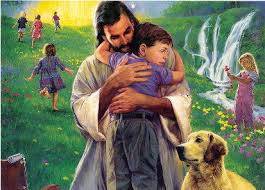
Jamie Grace, with TobyMAC: "Hold Me"
http://www.youtube.com/watch?v=ISgr8SgCYbY
Jesus touched people. His presence touched their souls. His gaze pierced their psyches. His message of forgiveness and change transformed hearts. Jesus touched people.
Touch is the first sense we acquire. A baby is born – ideally it is placed in its mother’s and father’s loving arms, gently cleaned, swaddled, hugged and kissed, lovingly touched -- all the while being poked and prodded by doctors and nurses. Our skin is our largest organ – making touch spread throughout our entire body. In that famous picture by Michelangelo, humankind is brought to life by God – not by the speaking of a word, a bolt of lightning, but by the touch of the outstretched divine hand. Reaching – touching humanity, imbuing life.
Jesus made touching a part of his ministry. He could have healed by just saying the word. But he did more. Often we see him touching the sick and outcast. He touched a man with leprosy (Matt. 8:2-3, Mark 1:40-42, Luke 5:12-13). He touched Peter’s mother in law (Matt. 8:14-15, Mark 1:30-31); a 12 year old girl in Capernaum (Matt. 9:25, Mark 5:41-42, Luke 8:54-55), the blind (Matt. 9:29-30 Mark 8:22-25 John 9:1, 6-7, Matt 20:30,33-34), deaf (Mark 7:32-35) a woman whose body was deformed (Luke 13:11-13), washing his disciples’ feet (John 13:1-17) – among many other examples. In some instances, Jesus frequently ran the risk of being considered “unclean” by touching someone “unclean” by disease, such as leprosy.
It is said that"healthy touch signals safety and trust, calms the cardiovascular system, activates the body’s vagus nerve (which is connected to compassionate response), releases oxytocin (the “love” hormone), stimulates the brain’s "happy" hormones, reduces blood pressure, reduces pain, increases pleasure, boosts the immune system, lessens symptoms of depression, and lessens fatigue and irritability." A hug, a shoulder rub, a double kiss to the cheeks, a playful head thump, a reassuring touch on the arm or back, holding a hand in prayer or in a time of illness or distress, a fist bump or high five -- go a long way to promote care and connection.*
It is a sad fact of modern life that we live in a touch-deprived society, while at the same time we must deal with the abuses of touch that have created a climate of guardedness. So we need to discern and even ask permission to touch. It is important that we not lose the capacity to touch in healing ways. Jesus touched because we are wired to be touched. Jesus physically touched those in need, and his presence touched countless lives. So we are called to convey loving care with touch, when it is appropriate. A discouraged child. A partner overwhelmed with anxiety. A dying relative. A friend battling depression. They all need our words of support and a reassuring touch.
So we follow the example of Jesus, touching the lives of others in all the ways we serve. As we touch, we are touched. Remember, today, every raindrop that falls on our face, the wind that weaves through our hair, the leaves our feet crunch on the path, the food and water we swallow, the licks from a dog happy you’re home, the myriad ways we experience human touch – are among God’s way to touch and hold us. As we become aware of all the ways God’s love touches us, let us take in this message: “… I hold you by your right hand--I, the LORD your God. And I say to you, 'Don't be afraid. I am here to help you” (Isa 41:13).
May we bring this message of touch to others as we go about our day.
Reflect and Pray: " Christ Has No Body"
Christ has no body but yours,
No hands, no feet on earth but yours,
Yours are the eyes with which he looks
Compassion on this world,
Yours are the feet with which he walks to do good,
Yours are the hands, with which he blesses all the world.
Yours are the hands, yours are the feet,
Yours are the eyes, you are his body.
Christ has no body now but yours,
No hands, no feet on earth but yours,
Yours are the eyes with which he looks
compassion on this world.
Christ has no body now on earth but yours..”
Teresa of Avila (1515–1582)
 RSS Feed
RSS Feed